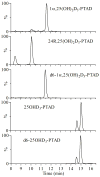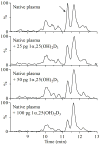Simultaneous measurement of plasma vitamin D(3) metabolites, including 4β,25-dihydroxyvitamin D(3), using liquid chromatography-tandem mass spectrometry
- PMID: 21784054
- PMCID: PMC3164754
- DOI: 10.1016/j.ab.2011.06.043
Simultaneous measurement of plasma vitamin D(3) metabolites, including 4β,25-dihydroxyvitamin D(3), using liquid chromatography-tandem mass spectrometry
Abstract
Simultaneous and accurate measurement of circulating vitamin D metabolites is critical to studies of the metabolic regulation of vitamin D and its impact on health and disease. To that end, we have developed a specific liquid chromatography-tandem mass spectrometry (LC-MS/MS) method that permits the quantification of major circulating vitamin D(3) metabolites in human plasma. Plasma samples were subjected to a protein precipitation, liquid-liquid extraction, and Diels-Alder derivatization procedure prior to LC-MS/MS analysis. Importantly, in all human plasma samples tested, we identified a significant dihydroxyvitamin D(3) peak that could potentially interfere with the determination of 1α,25-dihydroxyvitamin D(3) [1α,25(OH)(2)D(3)] concentrations. This interfering metabolite has been identified as 4β,25-dihydroxyvitamin D(3) [4β,25(OH)(2)D(3)] and was found at concentrations comparable to 1α,25(OH)(2)D(3). Quantification of 1α,25(OH)(2)D(3) in plasma required complete chromatographic separation of 1α,25(OH)(2)D(3) from 4β,25(OH)(2)D(3). An assay incorporating this feature was used to simultaneously determine the plasma concentrations of 25OHD(3), 24R,25(OH)(2)D(3), 1α,25(OH)(2)D(3), and 4β,25(OH)(2)D(3) in healthy individuals. The LC-MS/MS method developed and described here could result in considerable improvement in quantifying 1α,25(OH)(2)D(3) as well as monitoring the newly identified circulating metabolite, 4β,25(OH)(2)D(3).
Copyright © 2011 Elsevier Inc. All rights reserved.
Figures






Similar articles
-
Overcome Isomer Interference in 1α,25-Dihydroxyvitamin D Quantitation by Liquid Chromatography-Tandem Mass Spectrometry.J Appl Lab Med. 2022 May 4;7(3):737-746. doi: 10.1093/jalm/jfab112. J Appl Lab Med. 2022. PMID: 34632483
-
Candidate Reference Measurement Procedure for the Determination of (24R),25-Dihydroxyvitamin D3 in Human Serum Using Isotope-Dilution Liquid Chromatography-Tandem Mass Spectrometry.Anal Chem. 2015 Aug 4;87(15):7964-70. doi: 10.1021/acs.analchem.5b01861. Epub 2015 Jul 24. Anal Chem. 2015. PMID: 26171884
-
Chromatographic separation of dihydroxylated vitamin D3 and accurate quantification of 1α,25(OH)2D3 in human serum.J Pharm Biomed Anal. 2025 Aug 18;266:117125. doi: 10.1016/j.jpba.2025.117125. Online ahead of print. J Pharm Biomed Anal. 2025. PMID: 40839996
-
The serum vitamin D metabolome: What we know and what is still to discover.J Steroid Biochem Mol Biol. 2019 Feb;186:4-21. doi: 10.1016/j.jsbmb.2018.09.003. Epub 2018 Sep 8. J Steroid Biochem Mol Biol. 2019. PMID: 30205156 Free PMC article. Review.
-
Vitamin D and metabolites measurement by tandem mass spectrometry.Rev Endocr Metab Disord. 2013 Jun;14(2):159-84. doi: 10.1007/s11154-013-9241-0. Rev Endocr Metab Disord. 2013. PMID: 23539484 Review.
Cited by
-
Characterizing antibody cross-reactivity for immunoaffinity purification of analytes prior to multiplexed liquid chromatography-tandem mass spectrometry.Clin Chem. 2012 Dec;58(12):1711-6. doi: 10.1373/clinchem.2012.185827. Epub 2012 Sep 11. Clin Chem. 2012. PMID: 22968104 Free PMC article.
-
An ultrasensitive UHPLC-ESI-MS/MS method augmented with a controlled microwave derivatization reaction for quantitation of vitamin D3 and its major metabolites in COVID-19 patients.Talanta. 2022 Aug 15;246:123497. doi: 10.1016/j.talanta.2022.123497. Epub 2022 Apr 22. Talanta. 2022. PMID: 35487016 Free PMC article.
-
Measurement of circulating 25-hydroxyvitamin D: A historical review.Pract Lab Med. 2015 May 12;2:1-14. doi: 10.1016/j.plabm.2015.04.001. eCollection 2015 Aug 1. Pract Lab Med. 2015. PMID: 28932799 Free PMC article. Review.
-
Evaluation of Vitamin D Metabolism in Patients with Type 1 Diabetes Mellitus in the Setting of Cholecalciferol Treatment.Nutrients. 2020 Dec 18;12(12):3873. doi: 10.3390/nu12123873. Nutrients. 2020. PMID: 33352890 Free PMC article.
-
CYP3A4 mutation causes vitamin D-dependent rickets type 3.J Clin Invest. 2018 May 1;128(5):1913-1918. doi: 10.1172/JCI98680. Epub 2018 Apr 3. J Clin Invest. 2018. PMID: 29461981 Free PMC article.
References
-
- Plum LA, DeLuca HF. Vitamin D, disease and therapeutic opportunities. Nat Rev Drug Discov. 2010;9:941–955. - PubMed
-
- DeLuca HF. The vitamin D story: a collaborative effort of basic science and clinical medicine. The FASEB Journal. 1988;2:224–236. - PubMed
-
- Holick MF. Vitamin D Deficiency. N Engl J Med. 2007;357:266–281. - PubMed
Publication types
MeSH terms
Substances
Grants and funding
LinkOut - more resources
Full Text Sources
Other Literature Sources
Medical

